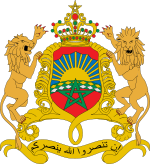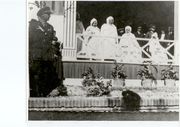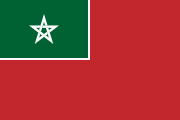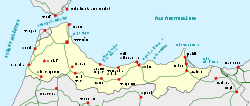Spanish Morocco
|
|||||||||||||||||||||||||||||||||||||
| History of Morocco | |
|---|---|
 This article is part of a series |
|
| Ancient Morocco | |
| Prehistoric and Berber Morocco | |
| Mauretania Tingitana | |
| Byzantine Empire | |
| 7th–11th century | |
| Umayyad conquest | |
| Masmuda Confederacy | |
| Berber Revolt | |
| Barghawata Confederacy | |
| Emirate of Sijilmassa | |
| Kingdom of Maghrib al Aqsa | |
| 11th–14th century | |
| Caliphate of Cordoba | |
| Kingdom of the Almoravids | |
| Almohad Caliphate | |
| Fez-Morocco | |
| Kingdom of Morocco (1215–1659) Kingdom of Marrakech, Kingdom of Fez |
|
Empire of Morocco (1666–late 19th C.) Kingdom of Marrakech, Kingdom of Fez, Kingdom of the Souss, Kingdom of Sijilmassa, Land of Draa, Bled-es-Siba |
|
Sultanate of Morocco (late 19th C.–1957) Morocco, Bled-es-Siba, Tekna Confederation |
|
| Protectorate (1912–1956) | |
| Treaty of Fez | |
| French Morocco | |
| Spanish Morocco | |
| Rif Republic | |
| Modern Morocco (since 1956) | |
| Ifni War | |
| Sand War | |
| Green March | |
| Madrid Accords | |
|
Moroccan dynasties
Idrisid dynasty
Almoravid dynasty Almohad dynasty Marinid dynasty Wattasid dynasty Saadi dynasty Alaouite dynasty |
|
|
Related Topics
1970s in Morocco
1980s in Morocco 1990s in Morocco 2000s in Morocco Economic history Military history Postal history Imperial cities |
|
|
Morocco Portal |
Spanish Protectorate of Morocco (Arabic: حماية إسبانيا في المغرب) (Spanish: Protectorado Español de Marruecos) was the area of Morocco under colonial rule by the Spanish Empire, established by the Treaty of Fez in 1912 and ending in 1956, when both France and Spain recognized Moroccan independence.
Contents |
Territorial borders

The territories of Spanish Protectorate of Morocco included northern Morocco (except Ceuta and Melilla, which have been Spanish since the 16th and 15th century, respectively), the Tarfaya Strip, and Ifni. The capital of Spanish protectorate of Morocco was Tetuán (Tétouan).
The rest of the country was ruled by France, under the name of French Morocco, also from 1912 to 1956.
The city of Tangier was declared an international zone, though this status was suspended during World War II when it was provisionally occupied by Spanish troops, from 14 June 1940, on the pretext that an Italian invasion was imminent[1].
The Republic of the Rif led by the guerrilla leader Abd El-Krim was a breakaway state that existed in the Rif region from 1921 to 1926, when it was dissolved by joint expedition of the Spanish Army of Africa and French forces during the Rif War.
Spanish historical claims
Ceuta had been Portuguese before becoming Spanish in 1580. Melilla had been part of Spain since 1497, neither was included formally in the Protectorate, but were ruled with the same provisions as in the rest of the Spanish mainland territory. As for the plazas de soberanía, most of them they were only gained after by the middle of the 19th century and, specially, after 1912 and the First Moroccan Crisis.
In the late 19th century, Queen Isabella II of Spain encouraged the officers of southern Spain to curb the migration of unauthorized poor Spaniards to the new territories.
History

The Protectorate system was established during the Second Spanish Republic. The legal Islamic qadis system was formally maintained.
The Moroccan Sephardi Jews—many of them living in this part of the Maghreb after being expelled from Spain and Portugal in 1492 and 1497 respectively after the end of the Reconquista process—flourished in commerce, profiting from the similarity of Spanish and Ladino language and benefiting from the tax-exempt area in Tangier and a flourishing trading activity in the area.
The Spanish Civil War started in 1936 with the uprising of the Spanish troops stationed in África (as the Protectorate was informally known in the Spanish military parlance) under the command of Francisco Franco against the Republican Government. These troops became the core of the Nationalist Army, which also recruited a considerable number of Moroccan troops.
The Communist parties; the PCE and POUM, advocated anti-colonialist policies whereby the Republican Government would support the independence of Spanish Morocco, intending to create a rebellion in Franco's back and cause disaffection among his Moroccan troops. However, the Republican Government under the PSOE rejected any such idea - which would have likely resulted in conflict with France, the colonial ruler of the other portion of Morocco.[2]
Because the local Muslim troops had been among Franco's earliest supporters, the protectorate enjoyed more political freedom than Franco-era Spain proper after Franco's victory [3], with competing political parties and a Moroccan nationalist press, criticizing the Spanish government.
In 1956, when French Morocco became independent, Spain discontinued the Protectorate and surrendered the territory to the newly independent kingdom while retaining the plazas de soberanía and other colonies outside Morocco, such as Spanish Sahara.
Unwilling to accept this, the Moroccan Army of Liberation waged war against the Spanish forces and in the Ifni War of 1958, spreading from Sidi Ifni to Rio de Oro, gained Tarfaya. In 1969, Morocco obtained Ifni. Morocco claims Ceuta and Melilla as integral parts of the country, considering them to be under foreign occupation, comparing their status to that of Gibraltar, while Spain regards them as constituent parts of its territory.
List of High Commissioners
- Felipe Alfau y Mendoza (April 3, 1913 to August 15, 1913)
- José Marina Vega (August 17, 1913 to July 9, 1915)
- Francisco Gómez Jordana, 1st term (July 9, 1915 to January 1919)
- Dámaso Berenguer (January 1919 to July 13, 1922)
- Ricardo Burguete Lana (July 15, 1922 to January 22, 1923)
- Luis Silvela y Casado (February 16, 1923 to September 14, 1923)
- Luis Aizpuru (September 25, 1923 to October 16, 1924)
- Miguel Primo de Rivera (October 16, 1924 to November 1925)
- Jose Sanjurjo Sacanell Buenrostro, 1st term (November 1925 to 1928)
- Francisco Gómez Jordana, 2nd term (1928 to 1931)
- Jose Sanjurjo Sacanell Buenrostro, 2nd term (April 19, 1931 to June 20, 1931)
- Luciano López Ferrer (June 20, 1931 to May 1933)
- Juan Moles Ormella, 1st term (May 1933 to January 23, 1934)
- Manuel Rico Avello (January 23, 1934 to March 1936)
- Juan Moles Ormella, 2nd term (March 1936 to July 1936)
- Arturo Álvarez-Buylla, acting (from July 18, 1936)
- Eduardo Sáenz de Buruaga (1936)
- Francisco Franco (1936)
- Luis Orgaz y Yoldi, 1st term (1936 to 1937)
- Juan Beigbeder y Atienza (August 1937 to 1939)
- Carlos Asensio Cabanillas (February 1940 to May 12, 1941)
- Luis Orgaz y Yoldi, 2nd term (May 12, 1941 to March 4, 1945)
- José Enrique Varela Iglesias (March 4, 1945 to March 24, 1951)
- Rafael García Valiño y Marcén (March 1951 to April 7, 1956)
See also
- History of Morocco
- History of Spain
- List of Spanish colonial wars in Morocco
- Spanish Legion
- Regulares
- Spanish Guinea
- Ahmed Belbachir Haskouri
- French protectorate of Morocco
References
Further reading
- Hardman, Frederick (2005). The Spanish Campaign in Morocco. W. Blackwood and sons. http://books.google.com/books?id=lkOXLMhNqLcC.
- "Min Khalifa Marrakesh Ila Mu’tamar Maghreb El Arabi." (From the caliph of the king of Morocco to the Conference of the Maghreb). (1947, April). El Ahram.
- Wolf, Jean (1994). Les Secrets du Maroc Espagnol: L’epopee D’Abdelkhalaq Torres. Morocco: Balland Publishing Company
- Ben Brahim, Mohammed (1949). Ilayka Ya Ni Ma Sadiq (To you my dear friend). Tetuan, Morocco: Hassania Publishing Company
- Benumaya, Gil (1940). El Jalifa en Tanger. Madrid: Instituto Jalifiano de Tetuan

